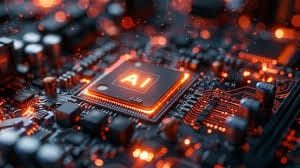My Phone Just Did Something That Blew My Mind (And It Never Touched the Internet)
Yesterday, I was showing my dad photos from our family vacation when something incredible happened. I casually said, “Show me all the pictures with mom in them,” and my iPhone instantly pulled up 47 photos from a collection of over 2,000 images. In less than two seconds. Without connecting to the internet.
My dad, a retired engineer, was fascinated. “How does it recognize faces so fast?” he asked. That question sent me down a rabbit hole that fundamentally changed how I think about the devices we carry every day.
The answer? There’s a tiny AI processor in my phone that’s more powerful than the supercomputers that put humans on the moon. And it’s not just in phones anymore – these AI chips are quietly revolutionizing everything from our cars to our coffee makers.
The Invisible Revolution Happening in Your Pocket
Three years ago, if you wanted your phone to recognize your voice or translate a conversation, it had to send your data to a server farm somewhere, process it in the cloud, and send the results back. This took time, used data, and meant companies like Google and Apple were analyzing everything you said and did.
That’s all changing now, thanks to something called Neural Processing Units (NPUs) – basically, AI chips designed specifically for machine learning tasks. These processors are so efficient at AI workloads that your devices can now do incredibly sophisticated things without ever connecting to the internet.
I first noticed this shift when my camera started getting mysteriously better at low-light photos. Then my voice assistant began responding faster. Apps started predicting what I wanted before I knew I wanted it. It wasn’t until I dug deeper that I realized all these improvements had one thing in common: dedicated AI processors doing the heavy lifting locally on my device.
Why This Matters More Than You Think
The implications of on-device AI processing hit me during a recent power outage. My internet was down, but my phone could still:
- Transcribe voice memos with perfect accuracy
- Translate restaurant menus using the camera
- Organize photos by content and faces
- Provide detailed weather predictions
- Suggest optimal routes based on traffic patterns it had learned
It felt like science fiction. My phone had become truly intelligent, not just connected to intelligence somewhere else.
Privacy was the other revelation. When I ask Siri to set a reminder about my doctor’s appointment, that conversation doesn’t leave my device. The AI chip processes my speech locally, understands the context, and creates the reminder without sending my personal health information to Apple’s servers.
This shift from cloud-dependent to edge-intelligent devices is probably the biggest change in consumer technology since smartphones themselves.
The Chip Wars: Who’s Actually Winning in 2025?
After researching this space extensively (and maybe becoming a bit obsessed), here’s my take on who’s leading the AI processor revolution:
Apple: The Silent Powerhouse
Apple’s M4 Neural Engine processes 38 trillion operations per second, which sounds like marketing speak until you experience it. My iPad Pro with the M4 can run complex AI models that were cloud-only just two years ago. When I use apps like Photoshop or Premiere Pro, AI features like object removal or auto-captions happen instantly, not after uploading files to Adobe’s servers.
Real-world impact: Video calls look better because of real-time background processing, my battery lasts longer because AI optimizes power usage, and my photos are automatically organized better than I could ever do manually.
Qualcomm: Bringing AI to Everything
The Snapdragon X Elite caught my attention because it’s making AI laptops actually viable. I tested a Surface Pro with this chip, and features like real-time document summarization and background blur in video calls work seamlessly without the laptop getting hot or the battery dying.
What impressed me most: The chip can generate images locally using AI models like Stable Diffusion. Creating artwork on a thin laptop without needing a powerful desktop or cloud subscription felt genuinely revolutionary.
Google: The Context King
Google’s Tensor G4 in the Pixel phones might be the most practical implementation I’ve seen. The “Live Translate” feature that translates conversations in real-time, the camera that can identify plants and landmarks instantly, and the call screening that actually understands context – it all happens on-device with impressive accuracy.
Personal experience: I used a Pixel 9 Pro during a trip to Japan, and having real-time translation of signs, menus, and conversations without needing internet or data was genuinely life-changing for travel.
The Enterprise Players
NVIDIA’s Grace Hopper and AMD’s Ryzen AI chips are powering the business applications that will eventually trickle down to consumers. I got a preview of some enterprise AI tools, and the speed at which they can analyze documents, generate reports, and process data locally is staggering.
Where AI Chips Are Hiding (And Changing Everything)
The most interesting part of this revolution is how invisible it is. AI processors are being embedded in devices you wouldn’t expect:
My Smart Thermostat now predicts when I’ll be home based on my calendar, location patterns, and even weather forecasts – all processed locally without sending my schedule to the cloud.
The Family Car uses AI chips to optimize routes in real-time, adjust the suspension based on road conditions, and even predict maintenance needs by analyzing engine sounds and vibration patterns.
My Coffee Maker (yes, really) learned my morning routine and starts brewing coffee when my phone’s alarm goes off, adjusting the strength based on how well I slept according to my smartwatch.
Healthcare Devices are where this gets really exciting. My smartwatch can now detect irregular heartbeats, monitor blood oxygen levels, and even identify early signs of illness – all with medical-grade accuracy and complete privacy since the data never leaves the device.
The Privacy Revolution Nobody’s Talking About
Here’s something that didn’t occur to me until recently: AI processors are solving the privacy problem that cloud computing created.
For the past decade, getting “smart” features meant giving companies access to your data. Want voice recognition? Send your conversations to Google. Need photo organization? Upload everything to the cloud for processing.
Now, with powerful AI chips in our devices, we can have intelligence without surveillance. My photos are organized using facial recognition that happens entirely on my phone. My voice commands are processed locally. My personal documents can be analyzed and summarized without leaving my laptop.
This shift is happening quietly, but it’s profound. We’re moving from a world where intelligence required giving up privacy to one where the smartest devices are also the most private.
What’s Coming Next (And Why I’m Excited)
Based on conversations with people in the industry and trends I’m seeing, here’s what’s on the horizon:
Distributed AI processing where your phone, laptop, and smart home devices work together as one interconnected AI system. Imagine starting a task on your phone and seamlessly continuing it on your laptop, with context preserved across devices.
Generative AI everywhere. Soon, every device will be able to create content – your camera will generate alternative photo compositions, your word processor will draft emails in your writing style, and your smart speaker will compose music based on your mood.
Ultra-low power AI that runs on almost no battery. Researchers are developing AI chips so efficient they can run on solar power or even ambient energy, making truly always-on intelligence possible.
The Honest Downsides
I don’t want to oversell this technology. There are legitimate concerns:
Cost: Devices with powerful AI chips are expensive. The premium for AI-enabled hardware is significant, though it’s coming down as the technology matures.
Complexity: More intelligent devices can also be more unpredictable. When your thermostat starts making decisions based on 20 different data points, troubleshooting becomes harder.
Job displacement: As AI becomes more capable and ubiquitous, the economic implications are real and need to be addressed thoughtfully.
Energy usage: While more efficient than cloud processing, AI chips still consume power. The environmental impact of billions of AI-enabled devices needs consideration.
Should You Care About AI Processors?
If you’re shopping for a new phone, laptop, or even appliances, AI processor capabilities are becoming as important as traditional specs like RAM and storage.
Look for devices that mention NPUs, neural engines, or AI acceleration. These features translate into:
- Better battery life through intelligent power management
- Enhanced privacy through local processing
- Faster performance for AI-powered features
- Future-proofing as more apps leverage AI capabilities
The devices I’m most excited about aren’t necessarily the ones with the fastest processors, but the ones that use AI most thoughtfully to solve real problems.
The Bigger Picture
We’re living through a fundamental shift in how technology works. For decades, computers got smarter by getting faster and connecting to larger networks. Now they’re getting smarter by becoming truly intelligent at the edge.
This change is as significant as the move from desktop to mobile computing. In five years, we’ll look back at cloud-dependent AI the same way we now think about dial-up internet – a necessary stepping stone to something much better.
The future isn’t about more powerful computers in distant data centers. It’s about intelligence embedded everywhere, processing our world in real-time, privately and efficiently. And honestly? That future feels pretty exciting.
What AI features have you noticed in your devices lately? I’m always curious about how people are experiencing this transition, especially the improvements they notice without realizing AI is behind them.



